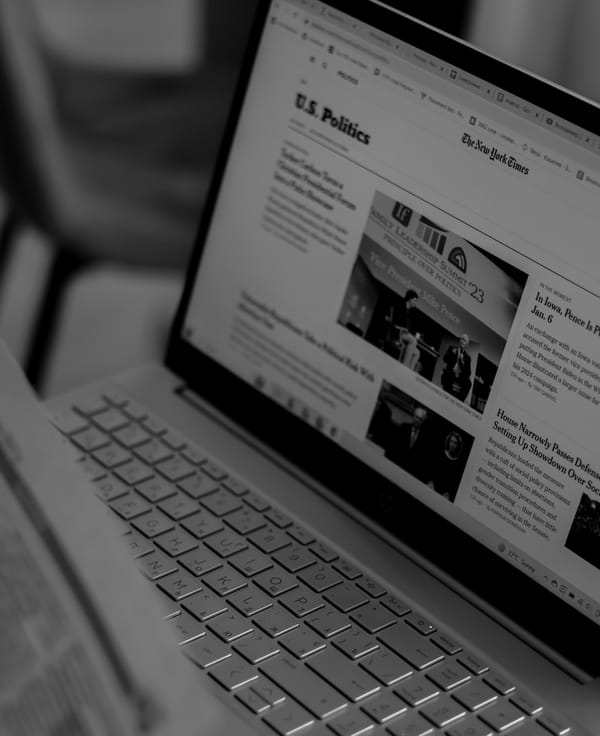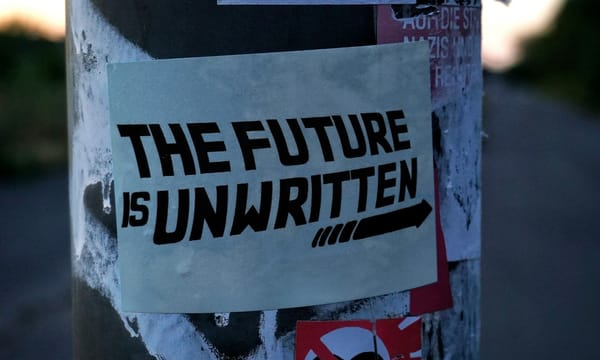Five Reasons Mainstream Media Downplays Autocracy & Why It’s Dangerous
This post is a wake-up call to anyone still waiting for the mainstream press to sound the alarm. They won’t, and here’s why.

Let’s stop pretending.
When Politico describes Erdoğan’s arrest of his political rival as a “lurch toward autocracy,” it’s not just bad journalism—it’s dangerous disinformation. When Reuters reports on Trump’s mass purges of federal employees without naming them for what they are—authoritarian power grabs— they’re not protecting objectivity. They’re protecting access.
In 2025, we are not watching democracies erode.
We are watching them collapse in real time, cloaked in:
- passive voice,
- carefully laundered euphemisms, and
- editorial cowardice.
This post is a wake-up call to anyone still waiting for the mainstream press to sound the alarm. They won’t. And here’s why.
1. They Prioritize “Diplomacy” Over Accuracy
When you report on powerful institutions—NATO, the U.S. State Department, foreign governments—telling the truth gets complicated. That’s because these systems rely not on truth, but on diplomacy: strategic silence, euphemism, and backchannel agreements that preserve the appearance of stability.
Mainstream news outlets like Politico, Reuters, and The New York Times often embed their foreign affairs desks within this culture. They’re granted interviews, access to officials, briefings, and leaks, as long as they don’t make things too uncomfortable.
So when Turkey imprisons a political rival?
- They don’t say “authoritarian consolidation.”
- They say “a controversial legal move.”
When Trump fires 100,000 federal workers and replaces them with loyalists?
- They don’t say “civil service purge.”
- They say “government restructuring.”
Truth is sacrificed on the altar of access.
Because calling out autocracy truthfully risks making things awkward at the next press conference.
2. They’re Trapped in the “Both Sides” Paradigm
Mainstream journalism in the U.S. still operates under a Cold War-era ideal: objectivity means neutrality. And neutrality means don’t pick a side.
Even when one side is openly criminalizing dissent, banning books, and rewriting constitutional limits on executive power.
So instead of calling authoritarian actions what they are, they present a carefully hedged narrative:
- “Critics argue the move could undermine democracy…”
- “Supporters say it’s a necessary step to restore order…”
This is not balance. It’s complicity.
It tells readers that authoritarianism is a matter of opinion—rather than a measurable, observable collapse of democratic norms.
If democracy is dying, “both sides” journalism becomes a weapon.
And now, this false equivalence isn’t just being pushed by legacy media—it’s being coded into “balanced news” platforms like Ground News, AllSides, and SmartNews. These apps claim to help users “see all sides,” but what they really do is curate emotional resonance masquerading as objectivity. They don’t assess which articles are factually accurate or rooted in evidence. Instead, they assign stories a political leaning—left, center, or right—and let you decide which version of reality feels best to you.
It’s an emotional sorting machine. Not a truth-telling one.
And it’s deeply dangerous.
By treating propaganda and journalism as interchangeable, these platforms normalize the idea that all knowledge is just perspective, that nothing can be proven, and that every truth has an equal and opposite alternative. That’s not balance. That’s algorithmic nihilism. And it’s one of the fastest ways authoritarianism becomes normalized—not just through media, but through the very tools people use to “educate themselves.”
3. They’ve Internalized the Myth of Western Democratic Exceptionalism
Media outlets in the U.S. and Europe cannot emotionally process the idea that their own governments might be authoritarian. That’s for other countries. That’s for “the global south,” or “the East,” or “illiberal democracies.”
So they twist themselves into knots to preserve the illusion of democratic continuity—even as voting rights are stripped, courts are packed, journalists are purged, and dissent is criminalized.
- This is why Trump’s America is called “polarized,” not “autocratic.”
- It’s why Erdoğan is “controversial,” not dictatorial.
- It’s why Hungary is “slipping” into autocracy, even though Orbán rewrote the entire constitution over a decade ago.
They are not reporting what is. They are reporting what they wish still were.
4. They Rely on State-Backed Narratives to Define “Pro-Democracy”
Let’s talk about Voice of America (VOA) and Radio Free Europe/Radio Liberty (RFE/RL), two U.S.-funded media outlets that operate internationally, broadcasting “objective news” into authoritarian regimes.
These outlets often do real journalism. But they are also soft-power tools, designed to reinforce U.S. geopolitical narratives. And the mainstream press treats their framing—who’s democratic, who’s authoritarian, who deserves intervention—as gospel.
That’s how you get the word “pro-democracy” used to describe:
- U.S. allies who violate human rights (Israel, Saudi Arabia, Turkey)
- Opposition movements the U.S. favors (regardless of their own authoritarian leanings)
- Institutions that serve U.S. interests, even if they undermine democracy at home
“Pro-democracy” becomes propaganda code. Not a value. Not a principle. Just a label for whose side you’re on.
And the press eats it up.
5. They Profit From the Illusion That We’re Not Already Losing
If a news outlet tells you that democracy is dead, what’s left to write about?
If elections are rigged, if press freedom is gone, if authoritarianism is already here—what story remains?
To keep readers engaged, the press has to keep the illusion alive. That this is just a “dangerous trend.” That “the next election will be pivotal.” That democracy is “on the brink”—but not over the edge.
Because once the public realizes the system has already collapsed?
- They stop trusting the press.
- They start organizing outside it.
- And that threatens the media’s business model.
It’s not that they can’t tell the truth. It’s that they’re not structurally built to survive it.
Euphemism is the Language of Empire
Authoritarianism does not announce itself. It arrives dressed in bureaucracy, legalese, and media spin.
- If the press keeps calling dictatorship a “shift,”
- if they call mass purges “personnel changes" or "restructuring,”
- if they describe repression as “controversial” instead of criminal—
- then they are not warning the public.
They are lulling it to sleep.
If your news source can’t call fascism what it is, stop reading it.
If your favorite journalist keeps both-sides-ing a dictatorship, call them out. And if you’re still waiting for someone to sound the alarm?
Be the alarm.
This Blog Isn’t Neutral & That’s the Point
You’re not going to find “both sides” journalism here. I don’t write to appease partisanship, and I don’t play respectability politics with fascism. I write with a clear stance: evidence over emotion, historical patterns over headlines, critical reasoning over cowardly neutrality. When I critique Politico or other mainstream outlets, it’s not because they’re useless—it’s because they’re often complicit in narrative laundering. They give platform to power and then pretend it’s balance.
I’m not here for that. I’m here to cut through it.
If you’re looking for centrist hedging or tone-policed objectivity, this isn’t the place.
But if you want real-talk grounded in receipts, welcome to the resistance.
In my next post….
I’m breaking down the rise of “balanced news” platforms—and how they quietly automate false equivalence, blur the line between journalism and propaganda, and make it harder than ever to tell truth from narrative. Stay tuned for Balanced Isn’t Truth: The Lie at the Heart of ‘Both Sides’ News.
Sources
- Benkler, Y., Faris, R., & Roberts, H. (2018). Network propaganda: Manipulation, disinformation, and radicalization in American politics. Oxford University Press.
- Entman, R. M. (2007). Framing bias: Media in the distribution of power. Journal of Communication, 57(1), 163–173. https://doi.org/10.1111/j.1460-2466.2006.00336.x
- Harsin, J. (2015). Regimes of posttruth, postpolitics, and attention economies. Communication, Culture & Critique, 8(2), 327–333. https://doi.org/10.1111/cccr.12097
- McChesney, R. W. (2004). The problem of the media: U.S. communication politics in the twenty first century. Monthly Review Press.
- Meyer, R. (2020, July 22). The media’s ‘both sides’ problem is back. The Atlantic. https://www.theatlantic.com/ideas/archive/2020/07/both-sides-journalism-is-back/614071/
- Open Society Foundations. (2021). False equivalence: How “balanced” media coverage enables authoritarianism. https://www.opensocietyfoundations.org/reports/false-equivalence
- Rutenberg, J. (2016, August 7). The challenge Trump poses to objectivity. The New York Times. https://www.nytimes.com/2016/08/08/business/media/the-challenge-trump-poses-to objectivity.html
- Vosoughi, S., Roy, D., & Aral, S. (2018). The spread of true and false news online. Science, 359(6380), 1146–1151. https://doi.org/10.1126/science.aap9559



